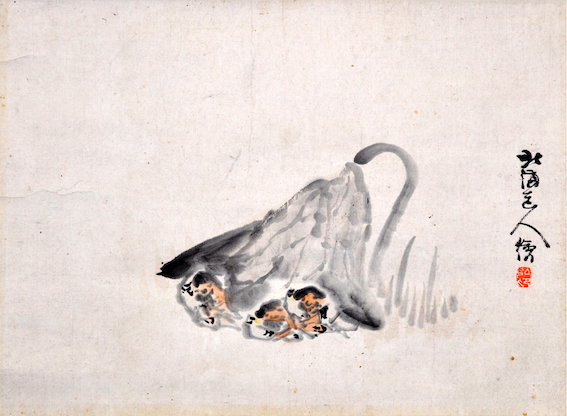On Korpokkur, or a "race" of small people in folklore of the Ainu people of the northern Japanese islands

On Korpokkur, or a "race" of small people in folklore of the Ainu people of the northern Japanese islands

アイヌ文化のロマン化あるいはコロポックル論争史の顛末につい て、ウィキペディアの資料を中心にまとめる。端的にいうと、コロポックルは、 異民族をみる(植民地搾取に関与する)和人たちが、異民族の特殊能力を「自分 たちと異なるもの」として空想的に表象するコロニアルな想像力のひとつである。和人がコロポックルに投影するメンタリティとは、小さくて不思議な存在で、 完全に「対等な関係にはなれない」存在である。その点で、映画『スターウォーズ』シリーズのイウォーク(Ewok)のように、帝国軍との戦争で、最終的に共和 国軍に協力する友好な「先住民族」とは、異なった性格が与えられているようである。21世紀の日本だけで、コロポックルの研究をすることに大きな意味はな く、スターウォーズのイウォークや、白雪姫に7人の小人(ドワーフ)についての比較参照あるいは対位法的読解が不可欠である
| 前史〜1885 |
 ・松浦武四郎作「蕗下コロポックル図」(市立函館博物館所蔵) ・坪井正五郎は、日本の石器時代、アイヌの祖先の渡来以前の日本に先住民がいたという、モースのいわゆるプレ・アイヌ説を継承し、アイヌの祖先がその先住 民を北方へ駆逐したという人種交代説を唱えた。彼はアイヌの伝承に着目し、それに現れるコロボックルは現在の大和民族ともアイヌ民族とも異なる民族で、彼 らこそが日本の先住民であると主張した。 ・1878年6月末浅草で、『大森村にて発見せし前世界古器物』を500人余に講演し、考古学の概要、『旧石器時代』『新石器時代』『青銅器時代』『鉄器 時代』の区分、大森貝塚が『新石器時代』に属することを述べ、出土した人骨に傷があり現在のアイヌには食人風習がないから「昔の日本には、アイヌとは別 の、食人する人種が住んでいた」と推論した[4]。演説会の主催および通訳は、江木高遠であった。(講演の中の『プレ・アイヌ説』は、考古学の主流になら なかった[5]。) ・「明治時代に入り,J.ミルンがコロボックルを日本の先住民であるとし,次いで渡瀬庄三郎が《人類学会報告》第1号(1886)で,札幌近郊の竪穴はコ ロボックルの住居だと発表し,坪井正五郎も同号で,日本の先住民である蝦夷はアイヌに限らないとして渡瀬に賛意を示した。」[中橋孝博] |
| 1886 |
1886年、動物学者の渡瀬庄三郎(1862
-1929)が『人類学会報告』創刊号にて札幌周辺に見られる竪穴住居の跡とみられるものがコロボックルの手によって作られたものであり、アイヌ人の前に
コロボックルがかの地に居住していた証拠であるという旨の発表を行い、それに坪井正五郎が『人類学会報告』第9号にて大筋賛成という意見の表明を行った。 ・ しかし『人類学会報告』9号にはさらに白井光太郎による匿名での坪井への反論が掲載され以降、小金井良精・浜田耕作・佐藤伝蔵・鳥居龍蔵・喜田貞吉など多 くの研究家がこの議論に参加した。 |
| 1887 |
|
| 1888 |
|
| 1889 |
|
| 1890 |
|
| 1891 |
十勝地方に残る伝説では、コロボックルはアイヌに迫害されたために土地
を去ったといわれ、去り際にアイヌに言った呪いの言葉「トカップチ(水は枯れろ、魚は腐れの意)」が十勝の地名の由来とされる[2]。類似の語源説が永田
方正の著書『北海道蝦夷語地名解』(1891年)に見え、同書では「幽厲」(原文ママ)を意味するアイヌ語に由来し「昔時十勝アイヌノ強暴ヲ悪ミシ詞ナリ
ト云フ」としている。 |
| 1892 |
|
| 1893 |
|
| 1894 |
|
| 1895 |
「コロボックルの衣服に付きては口碑甚不完全なり。或地のアイヌはコロ
ボックルの男子は裸体なりし由云へど」(出典:風俗画報‐九一号(1895)コロボックル風俗考) |
| 1896 |
|
| 1897 |
|
| 1898 |
|
| 1899 |
|
| 1900 |
|
| 1901 |
|
| 1902 |
|
| 1903 |
|
| 1904 |
|
| 1905 |
|
| 1906 |
|
| 1907 |
|
| 1908 |
|
| 1909 |
|
| 1910 |
|
| 1911 |
|
| 1912 |
|
| 1913 |
この論争は1913年、坪井がロシアのペテルスブルクで客死するまで続
く。 |
| 1914 |
|
| 1915 |
|
| 1916 |
|
| 1917 |
|
| 1918 |
小説家の宮本百合子はアイヌを題材にした「風に乗ってくるコロポック
ル」という短編小説を1918年に発表 |
| 1919 |
|
| 1920s |
|
| 1930s |
・違星北斗は、「石の下の人」という意味で、クルプンウンクル
(Kurupun, unkur)という発音を記録している。 |
| 1940s |
|
| 1950s |
・童話作家の佐藤さとるは、「コロボックル」という妖精の登場する「コ
ロボックル物語」と題したファンタジー小説シリーズを1959年より発表。 |
| 1960s |
|
| 1970s |
|
| 1980s |
・推理小説作家の西村寿行は、1987年に『コロポックルの河』を発表
している。 ・(1980s)パソコンまたは家庭用ゲーム機用のアドベンチャーゲームとして有名な堀井雄二の「北海道連鎖殺人 オホーツクに消ゆ」には、この妖精の名前をもじったと思われる「コロポックリ」という炉端焼き店が登場する。 |
| 1990s |
・漫画家の花輪和一は、コロポックルという名前の妖精の登場する『コロ
ポックル』と題した作品を1990年に発表した。 ・北千島のアイヌは、北海道アイヌや和人と大きな体格差はない。このことで千島アイヌの認識としては、次のようなことが語られている。鳥居龍蔵はパラサマ レックという34、5歳の千島アイヌの世話をしていたが[5; 中薗英助 『鳥居龍蔵伝 アジアを走破した人類学者』 岩波書店 1995年、12頁]、北海道アイヌと身長差が大してないにもかかわらず、小人扱いされ、千島アイヌを侮蔑した物語として創ったものと認識して激怒してい たという[6;『鳥居龍蔵伝 アジアを走破した人類学者』、70頁。]。 |
| 2000s |
・村上健司編著『妖怪事典』毎日新聞社、2000年、166頁 ・2008年1月18日の産経新聞では「アイヌは縄文人の血を最も直接的に引き継いでいるとみられている。」としている。朝日新聞社のホームページ asahi.com内の記事「街の記憶」では、「アイヌや沖縄の人たちは、縄文人の血を濃く受け継ぐ民族だといわれている。」とし、また同社の2007年 06月9日の記事において「日本人は(中略)縄文人からの遺伝形質は北海道のアイヌを除けば薄れてきたとされている。」と報道している。 ・2006年の第169回国会で可決された「アイヌ民族を先住民族とすることを求める決議案」は「アイヌの人々を日本列島北部周辺、とりわけ北海道におけ る先住民である」とした決議で、過去日本列島において縄文式土器を使っていた人々の子孫がアイヌ人であるという説には言及していない。 |
| 2010s |
・考古学者の瀬川拓郎は、コロポックルの特徴として語られる「交易の
際、相手との接触を避ける(沈黙交易)」、「竪穴式住居に住む」、「土器を製造、使用し、陶土を求めて他所の地にまで進出する」などの事例が北千島に住む
アイヌの習俗と共通することに着目し、さらに北海道から樺太、南千島に広く伝わるコロポックル伝説が北千島に限っては伝承されていないことから、「コロ
ポックルの正体は、北千島のアイヌである」との説を提唱している[4]。 |
| 2020s |
リンク
文献
その他の情報
Copyleft, CC, Mitzub'ixi Quq Chi'j, 1996-2099
☆
 ☆
☆